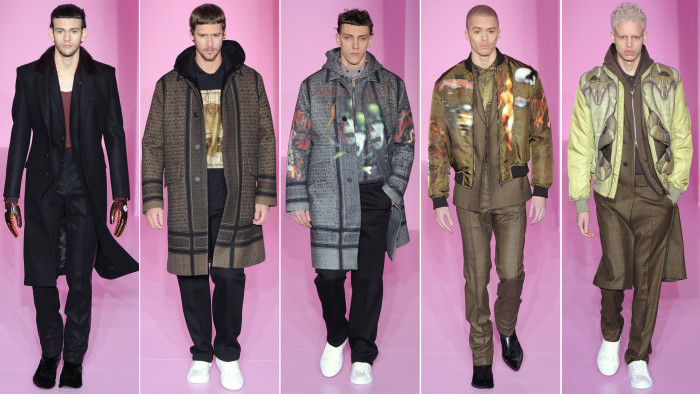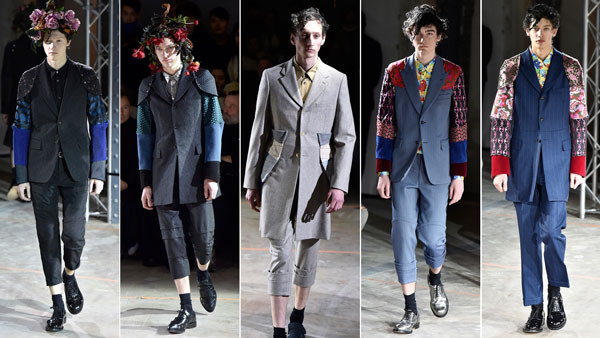Givenchy, Comme des Garçons Homme Plus, Berluti, Loewe AW16 report Paris menswear

Simply sign up to the Life & Arts myFT Digest -- delivered directly to your inbox.
After his Givenchy show, Riccardo Tisci said that he felt free. “It was all about freedom,” he said. It was his first show since his stellar womenswear collection in New York last September which seemed to elevate him. Now that Saint Laurent has temporarily moved its men’s show to Los Angeles, Givenchy is unrivalled as the commercial blockbuster of Paris men’s.
“All this inspiration that was coming into my head,” he continued, “the only way to bring it to the runway was to be free. It’s not thematic.” Maybe not, but it was rammed with product. Tailored coats went to the knee, as is the current menswear mood. Same for an MA1 flying jacket over tailoring.
Tisci would love for this tailoring to be the driving force of the Givenchy menswear business. In reality, retailers will be hankering for the T-shirts and sweatshirts that will bear new graffiti prints that were inspired by the motorbike gangs of Botswana. The brand’s name was rendered in lettering usually found on heavy metal album covers. There was a spray painted skull. Elsewhere, a cobra fully face on, a close-up view that if you saw it in real life, it’d probably be your last.
For the second season, Tisci showed examples of Givenchy women’s couture, which will be formally presented to the women’s press next week. Dresses were long, unstructured, sheer, sequinned. There sure was some work done on them, which showed a bit too clearly that the men’s had been produced in a factory. Best of the menswear were some patchwork quilted bombers, which took the shape of that snake. It showed an element of human hand and ingenuity. I told him it was nice to have the men’s be elevated. “It was more couture,” said Tisci. “Maybe men can wear couture. We deserve that as well. It’s not just for women.” Next time, move more of the men’s in that direction.
At Comme des Garçons Homme Plus, Rei Kawakubo showed her mastery of quiet power. The collection was deceptively simple, with articulated armour-like panels forming the sleeves of tailored jackets, or attached around the true waist as if a bustle. The fabric of these panels were sometimes of jarring, garish cloth, as if found on a market stall. A good thing.

It was a slow build of emotion, starting from the headpieces of fake flowers. Armour was softened, men came in peace. Some of the jackets were curious. Others, gorgeous. At the end, the models emerged laden with huge bouquets of fake flowers. They were not gifts for Kawakubo: as always, she took no bow. Her point was made.
A quick mention of Berluti, where the best ideas were the simplest, like tailoring in dull browns and blues, or raw-cut edge sweaters. Creative director Alessandro Satori attempted to create double-layerjackets and coats. It was appropriate as a jacket, where the underneath layer looked like a more relaxed waistcoat. The double-layer coats, with a double-coat collar, were like an early-career experiment by Viktor & Rolf. Sartori’s best work at Berluti is unassuming and elegant. He should keep away from the path of over design.
At Loewe, creative director Jonathan Anderson showed his best collection yet for the brand, with work of depth and thought. A sky blue soft linen jacket had been woven to look worn. Cargo pants were cut loose. Upstairs in his office, Anderson talked through some of the pieces. “These are my favourite looks,” he said of two raw-edged soft washed tweed coats. “I’ve always wanted to weave our own tweed.” The tweed had been woven in Scotland. Oversized army trousers had a large capital R painted in white on the front calf of one leg, a W on the other. “It means nothing,” he said, before going on to explain it was as if they had been personalised.
Long cardigans with an elongated rectangle stretching down the back had been inspired by 18th century Indonesian cloth. “They used to make these scarves for women when they got married,” he said. “They would tie-dye an actual rectangle.” Think about that for a moment. Remember tie-dyeing with a bucket and some string? Now imagine trying to create with that bucket and string a perfect rectangle of precise colour. “Rothko was obsessed with them,” he said. “They look like Rothko’s, but they’re actually pieces of fabric.” He opened a book and showed me one from 1730. It looked like a Rothko.
Had he tried to replicate the rectangular tie-dye technique? “We tried and we couldn’t do it.” Hence the long knit. What mattered here was the intent to investigate and create rather than just throw ideas around, which Anderson has been known to do. It was good to hear him talking about things that had meaning.
There was still his usual scattergun approach. “That’s a pterodactyl,” he said of a print on a blouse. Almost in the same breath, he was onto the next garment. “This is based on a shirt that had fag burns on it.” He tried burning a pattern into a shirt the same way, but said that it would be so laborious the end product would cost “like 13,000 euros”. The shirt he showed had been laser cut.
By the way, should you want to know the superlative currently favoured by today’s 31-year-old fashion designer, it’s “mega”. Anderson used it at least twice in our thirteen-minute conversation, once when he was talking about the new Dover Street Market store in London, which’ll have spaces for both Loewe and JW Anderson. He said he’s “mega-excited”. Mega.
For more reports from the shows, go to our fashion weeks page on FT.com
Photographs: Catwalking.com
Comments